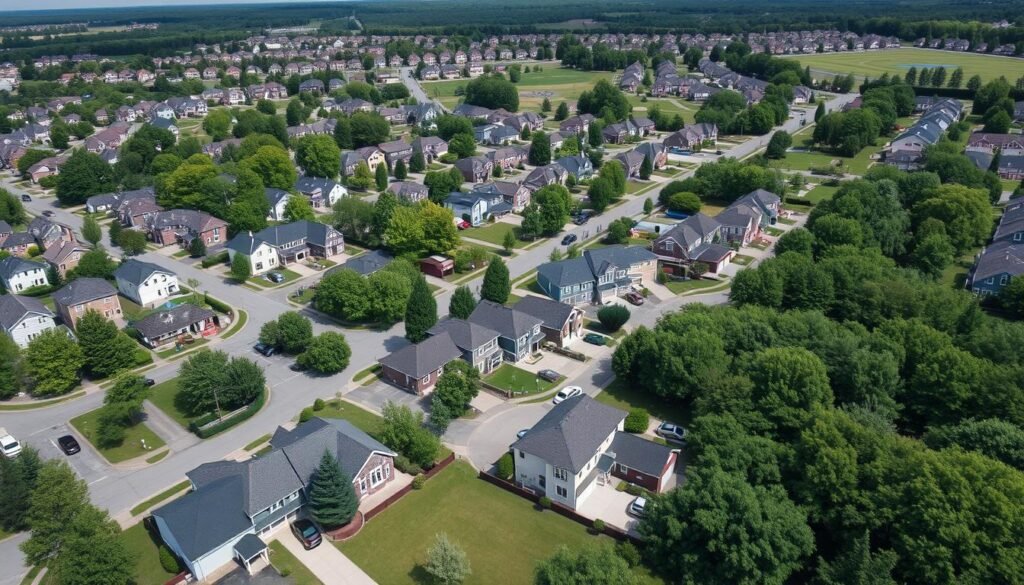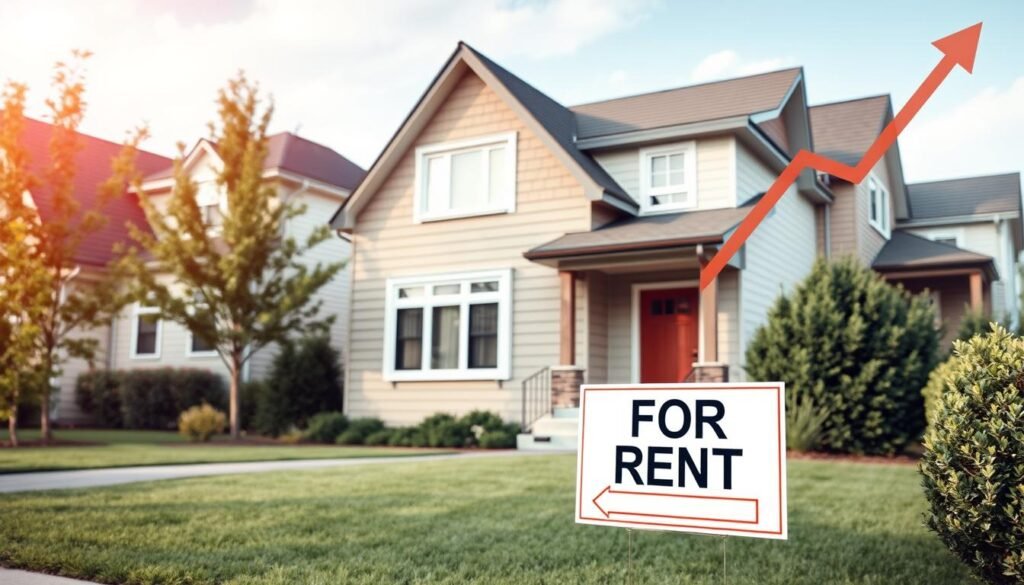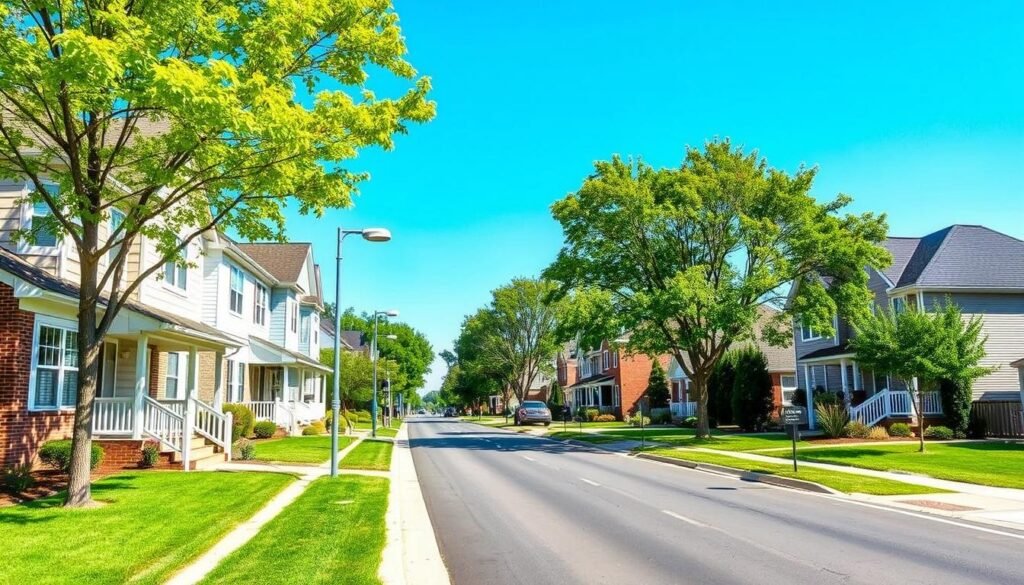Are you a savvy investor looking for lucrative rental opportunities? Clayton in Melbourne might be the place for you. With a variety of properties, from houses to units, it’s key to understand the rental yields and returns here. Let’s explore the data and see the potential of investing in Clayton.
Key Takeaways
- Clayton offers a median house price of $1,184,444 with -4.48% annual capital growth and a median unit price of $749,000 with 2.88% annual growth.
- Houses in Clayton spend an average of 30 days on the market, while units spend 44 days.
- The rental yield for houses in Clayton is 2.74% with a median weekly rent of $600, and for units, it’s 4.68% with a median weekly rent of $550.
- The population of Clayton experienced a 24.5% growth from 2011 to 2016, with the predominant age group being 20-29 years old.
- Clayton offers a diverse range of amenities, including 9 parks covering nearly 4.1% of the total area.
Introduction to Rental Yields and Returns
Investors need to know about rental yields and returns when looking at properties in Clayton. Rental yields show how much income a property makes each year compared to its value. This can change a lot based on the property type and where it’s located.
What Are Rental Yields?
Rental yields are a key way for investors to check if a property is profitable. They find this by dividing the yearly rent by the property’s cost. For instance, a 4% rental yield means the rent is 4% of the property’s value.
Why Are Rental Returns Important?
Rental returns are key to making more money from your investment. A higher yield means more profit, as it shows a better return on your investment. In Clayton, where property prices keep going up, it’s vital to calculate rental yield right. This helps find the best investment spots and maximize rental income.
Knowing about rental yields helps you choose the right properties. This way, you can get better returns and grow a strong investment portfolio in Clayton’s property market.
The Basics of Investment Properties
In Clayton, there are several types of investment properties to look at. The local market offers a wide range of options, from single-family homes to townhouses and units. The median listing prices are $1,110,000 for houses, $830,000 for townhouses, and $499,000 for units.
The value of a property in Clayton depends on its location, type, and market demand. Over the past year, units have seen the biggest price increase, at 10.88%.
Understanding Property Valuation
Getting the right value for a property in Clayton is key. The property’s condition, size, and location are important. So are the number of bedrooms and bathrooms, and how close it is to amenities.
Local market trends and rental demand also affect a property’s value. The 1% rule is a useful tool for checking a property’s investment potential. It says a property should earn at least 1% of its purchase price in monthly rent. This helps investors find properties with good return potential.
| Property Type | Median Listing Price | Rental Yield Growth |
|---|---|---|
| Houses | $1,110,000 | 7.92% |
| Townhouses | $830,000 | 9.14% |
| Units | $499,000 | 10.88% |
Knowing about the different property types in Clayton helps you make better investment choices. It lets you understand how to get the most from your investment property returns and use the local housing market trends to your advantage.
Calculating Rental Yields
Understanding rental yields is key for investment properties. Rental yield shows how much profit you make from your investment. It’s the annual rent as a percentage of the property’s value. Knowing how to calculate rental yields helps you make smart choices and boost your returns.
Formula for Rental Yield Calculation
The formula for rental yield is easy: Rental Yield = (Annual Rental Income / Property Value) x 100. This formula helps you figure out the return on your investment. It depends on the rent and the property’s value.
Gross vs. Net Rental Yield
- Gross Rental Yield: This looks at just the annual rent, ignoring expenses. It gives a basic idea of potential returns.
- Net Rental Yield: This includes the annual rent minus all property costs. It shows the real return on your investment.
In Clayton, houses have a gross rental yield of about 2.74%, and units have a yield of 4.68%. But, it’s important to look at the net yield. It gives a clearer view of what you can really earn.
| Property Type | Median Price | Median Weekly Rent | Gross Rental Yield | Net Rental Yield |
|---|---|---|---|---|
| Houses | $892,000 | $550 | 3.3% | Not Available |
| Units | $620,000 | $525 | 4.4% | Not Available |
By grasping the rental yield formula and the gross vs. net yield difference, you can better decide on calculating rental yield and assessing investment property returns in Clayton.
Factors Affecting Rental Yields in Clayton
Location is key when investing in rental properties, and Clayton is no exception. Its close proximity to Monash University greatly influences the local housing market. This makes it a hotspot for rental demand.
Clayton has seen a 24.5% population increase from 2011 to 2016. The main age group is 20-29 years. This has boosted demand for rentals, mainly from students and young professionals.
Location and Its Impact
Clayton’s location near Monash University significantly affects rental yields. It offers various housing types, from houses to units. These cater to the needs of students and young professionals.
Houses in Clayton have a median price of $1,184,444 and an annual growth of -4.48%. Rental yields are 2.74% with a median rent of $600 weekly. Units, priced at $749,000, have a 2.88% annual growth and a 4.68% rental yield. The average rent for units is $550 weekly.
Property Demand and Market Trends
Understanding local housing trends is crucial in Clayton. Over the last year, 92 houses and 217 units were sold. Houses took 30 days to sell, while units took 44 days.
While houses saw a slight decline in growth, units showed more promise. This reflects changing tenant preferences and demand. Tailoring property management strategies to these changes can help increase rental yields.

Comparing Rental Yields in Clayton to Other Suburbs
Clayton is a top choice for rental property investment in Melbourne. It offers good rental yields, even though it’s not the highest in Victoria. Clayton’s yields are close to the city’s average.
Yield Analysis of Nearby Areas
Houses in Melbourne’s suburbs average a 3.3% yield, while units average 4.4%. Clayton’s units, though, yield 4.68%. This is higher than the city’s average. It makes Clayton a great choice for investors looking for steady returns.
Benefits of Investing in Clayton
- Competitive rental yields, mainly for units
- Affordable property prices compared to other Melbourne suburbs
- Proximity to Monash University, attracting a large student population
- Diverse, multicultural community with a vibrant local culture
- Efficient public transportation options for tenants
- Ongoing population growth and development in the area
Clayton may not have the highest yields in Victoria. But its yields are still very attractive for Melbourne real estate and rental property investment in Clayton. The suburb’s affordability, strong rental demand, and convenient location make it a smart choice for investors.
The Role of Property Management in Yields
Effective property management can greatly improve rental yields in Clayton. Property managers help owners get the best returns by setting the right rent, keeping properties filled, and managing upkeep costs. They are key in Clayton, where many young renters live.
How Property Managers Can Affect Your Returns
Property managers boost your rental income in Clayton through various strategies. They use their market insight to set the best rent prices. This ensures you get the highest yield without losing out on the market.
They also pick the best tenants, reducing empty periods and risks of damage or unpaid rent. Their maintenance and repair management keeps costs down. They find good tradespeople, handle emergencies, and prevent big problems.
Key Services Offered by Property Management
- Rental pricing optimization
- Tenant screening and selection
- Rent collection and arrears management
- Property maintenance and repairs
- Compliance with local laws and regulations
- Regular property inspections and condition reports
- Marketing and advertising your property
- Handling tenant inquiries and complaints
By using a trusted property management company like Avenue Residential Leasing & Management, you can focus on your investment strategy. Your rental property in Clayton will be well-managed, ensuring it’s efficient and effective.
| Service | Typical Cost in Australia |
|---|---|
| Property Management Fees | 5% to 12% of weekly rent |
| Real Estate Agent Commission | Around 7.66% of weekly rent |
| Letting Fees | 1 to 2 weeks’ rent |
| Lease Renewal Fees | 1 week’s rent or a flat rate |
| Routine Maintenance Costs | $150 – $250 plus GST |
| Marketing and Advertising Fees | $300 to $1,500 |
| Landlord Insurance Costs | $300 to $1,000 annually plus GST |
By working with a professional property management company, you can increase your rental yields in Clayton. This makes your investment experience hassle-free.
Understanding Capital Growth
When you think about investment planning in Melbourne real estate, knowing about capital growth is key. Capital growth is when your property’s value goes up over time. This can give you a big return on your investment.
Capital Growth vs. Rental Yield
Rental yields are about the income you get right away from a property. Capital growth is about the property’s value going up over time. Both are crucial for judging how well an investment property does. Investors need to find a balance between them.
Long-term vs. Short-term Investments
- Investments in Melbourne real estate for the long term usually focus on capital growth. This is because the property’s value is expected to rise, giving a big return when sold.
- Short-term investments might focus more on rental yields. The aim here is to make money quickly from the property.
In Clayton, the data shows mixed results for capital growth. Houses have seen a -4.48% annual growth rate, while units have grown by 2.88%. But, over time, Clayton could see its value go up due to population growth and development.
| Property Type | Annual Capital Growth |
|---|---|
| Houses | -4.48% |
| Units | 2.88% |
When deciding on investments, it’s vital to look at both rental yield and capital growth. This gives a full picture of the property’s long-term success and profit potential.
Tax Implications of Rental Properties
Investing in Clayton means knowing about tax rules for rental properties. New land tax rules in Victoria have made things more complicated. They include a surcharge for those with multiple properties and a higher rate for absentee owners.
Deductions You Can Claim
To get the most from your investment, learn about the deductions you can take. You can claim costs for managing, keeping up, and fixing your properties. This includes repairs, taxes, maintenance, interest, utilities, insurance, and fees for property management.
You might also deduct closing costs, advertising, travel, and even losses from damage. The Qualified Business Income (QBI) deduction is another way to save on taxes. It lets eligible investors deduct 20% of their taxable income, under certain conditions.
Understanding Capital Gains Tax
When you sell your investment property, capital gains tax is important to think about. This tax is based on the sale price minus your original cost, adjusted for any upgrades or expenses. Working with a Certified Practising Accountant (CPA) can help you deal with this tax and increase your earnings.
| Tax Metric | Statistic |
|---|---|
| Individuals Claiming Net Rent with Taxable Income Less than $80,000 | 68.9% |
| Rental Losses Claimed by Individuals Earning Less than $80,000 | $2.781 billion (average of $2,050 per claimant) |
| Taxpayers with Income More than $80,000 Claiming Net Rent | 25.8% |
| Increase in Lending for Investment Housing (2000-2013) | 230% compared to 165% for owner-occupied housing |
By grasping the tax rules and using available deductions, you can boost your investment property returns. This helps you manage the risk assessment for landlords in Clayton effectively.
Financial Metrics for Investors
Investing in rental properties in Clayton requires understanding key financial metrics. These include rental yields, capital growth rates, and cash flow. They help assess your property’s performance.
Key Ratios to Know
The rental yield is crucial. It shows the annual rental income as a percentage of the property’s value. In Clayton, houses have an average yield of 2.74%, while units reach 4.68%.
Capital growth rates are also important. Houses in Clayton have seen a 4.48% annual decline. Units, on the other hand, have enjoyed a 2.88% increase.
Vacancy rates greatly affect returns. Keeping your property rented out consistently is key. It maximizes cash flow and investment performance.
Assessing Overall Investment Performance
By looking at these metrics and market trends, investors can understand their property’s performance. Comparing your investment to surrounding suburbs offers valuable insights. It helps in making informed decisions about your portfolio.
| Metric | Houses | Units |
|---|---|---|
| Median Price | $1,184,444 | $749,000 |
| Rental Yield | 2.74% | 4.68% |
| Capital Growth (12 months) | -4.48% | 2.88% |
| Median Rent (weekly) | $600 | $550 |
Keeping track of these metrics and adjusting your strategy can boost your calculating rental yield and investment property returns in Clayton.

Risks Associated with Rental Investments
Being a landlord in Clayton means knowing the risks of rental investments. The local housing market is growing, but there are many factors that can affect your property. It’s key to protect your financial future.
Common Investment Pitfalls
Landlords in Clayton worry about market changes. Rental prices have gone up, but this might not last. Changes in the economy, demographics, or new tax rules can all impact your property’s value.
Another issue is the number of young renters. They tend to move more often. This can lead to empty properties and extra costs for finding new tenants.
Mitigation Strategies
- Spread your investments across different areas or types of properties. This can help reduce risks tied to one market.
- Keep your rental homes in top condition. This attracts reliable tenants who are willing to pay more for quality.
- Keep up with Clayton’s housing market, rules, and changes in the population. This helps you make smart choices and adjust your plans as needed.
By tackling the risks of rental investments head-on, you can build a strong portfolio. This way, you can handle the changing risk assessment for landlords and local housing market trends in Clayton.
Strategies to Maximise Rental Yield
As a savvy investor, boosting your rental income is crucial. This is how you get the best returns from your Clayton property. Strategic renovations and smart marketing can unlock your property’s full potential.
Renovations and Upgrades
Renovations and upgrades can greatly increase your property’s rental value. Focus on what young professionals and students in Clayton like. Upgrades like modern kitchens and energy-efficient features can attract better tenants and higher rents.
Marketing Your Property Effectively
Good marketing is key to high rental yields. Emphasize your property’s closeness to Monash University and local amenities. Keep an eye on market rates to set the right rent and maximize your investment.
The Clayton rental market is growing fast, with units in high demand. Being quick to adapt your marketing can help you meet this demand.
| Rental Yield Optimization Strategies | Potential Impact |
|---|---|
| Conducting targeted renovations | Increased rental value and tenant appeal |
| Effective property marketing | Aligning rental rates with market conditions |
| Offering long-term lease agreements | Reduced vacancy periods and consistent income |
| Providing additional income streams | Diversifying revenue sources (e.g., storage, furnishings) |
| Efficient property management | Minimizing vacancy rates and maintenance costs |
By using these strategies, you can increase your rental income. This will help you reach your investment goals in the Clayton market.
The Future of Rental Yields in Clayton
The rental yields in Clayton are looking up, with units leading the way. This is thanks to Monash University’s growth and Clayton’s job opportunities. But, new land tax rules and changes in student numbers could influence these yields.
Emerging Trends in the Property Market
The Australian build-to-rent (BTR) market is small but growing fast. It has 11 BTR properties worth A$16.87 billion, making up 0.2% of homes. If it grows to 3% of the market, its value could hit A$290 billion.
The Federal Government is supporting BTR with tax breaks and removing GST. This aims to increase affordable housing.
Projections for Rental Yields
Good rental yields are above 4%. Apartments usually offer higher returns than houses or townhouses. Houses and townhouses are considered okay if they yield 3% to 4%.
Rental yields for commercial properties are often higher. But, they might grow less in value over time.
To find rental yield, use this formula: (Annual rental income / Property value) * 100. Remember to subtract costs like council rates and property management fees. Having a cash reserve for vacancies and income changes is key.
As the market and investment planning change, staying informed is vital. Making smart choices will help investors get the most from Clayton’s property market.
Conclusion and Next Steps
The Clayton property market has many investment options. Different types of properties offer varying rental yields and growth. Units often have higher yields and stronger growth than houses. But, it’s important to think about location, property type, and long-term growth when investing.
Making Informed Investment Decisions
To do well in Clayton’s property market, stay informed about trends, taxes, and rules. Look at rental yields, demand, and growth potential of different properties. This helps you make smart choices that fit your financial goals and risk level.
Resources for Further Research
To learn more about investing in Clayton and Melbourne’s real estate, check out industry reports and market analyses. Also, seek advice from experienced property advisors. Keeping up with the latest information helps you make confident investment decisions and increase your returns.



